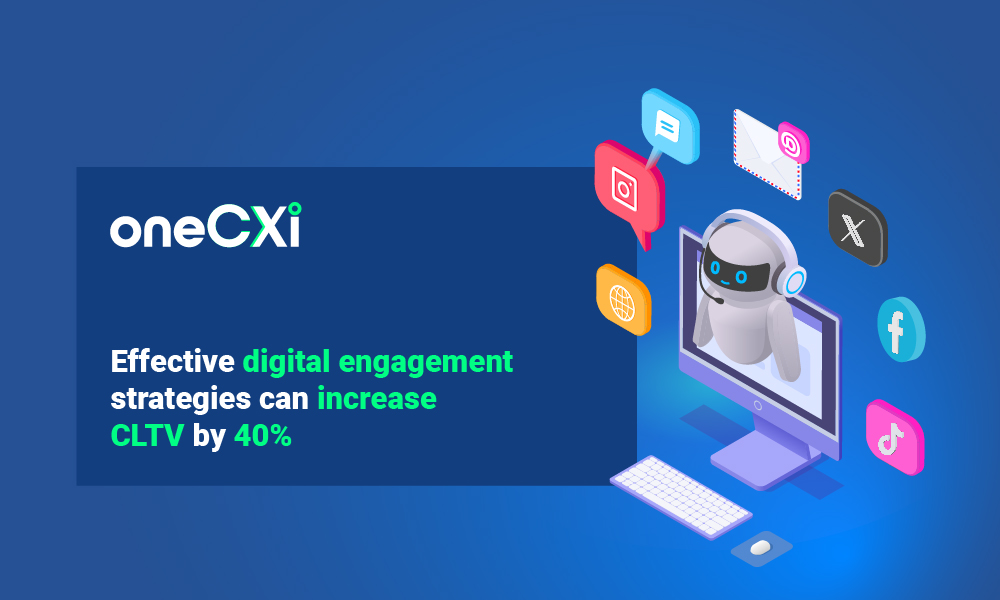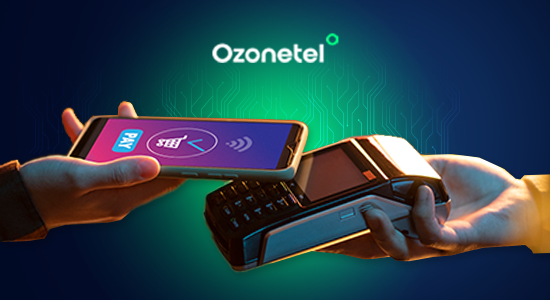- Resources
- Digital Customer Engagement: Everything You Need to Know
Digital Customer Engagement: Everything You Need to Know

Digital customer engagement is all about building meaningful, ongoing connections with your customers through digital channels. Whether it’s through social media, email, mobile apps, or online chat, engaging customers digitally ensures that you are not just understanding their needs and expectations
But why is this so important? A well-crafted digital engagement strategy fosters customer loyalty, enhances brand reputation, and boosts long-term revenue. And investing in multiple digital engagement strategies can help build lasting relationships and turn one-time buyers into lifelong advocates.
In this guide, we will explore the importance of digital customer engagement and the strategies you can implement to make the most of every digital interaction with your audience. Read along!
In this article, we will explore:
- 1.What is Digital Customer Engagement?
- 2. Digital Customer Engagement Vs Customer Engagement
- 3. Importance of Digital Customer Engagement
- 4.Digital Customer Engagement Strategies to Improve Customer Service
- 5.What are the Steps to Build Digital Customer Engagement Strategy?
- 6 Digital Customer Engagement vs Digital Customer Service
- 7.Examples and Industry Applications of Digital Customer Engagement
- 8.How Digital Customer Engagement Can Impact Business
- 9.List of Digital Engagement Tools
What is Conversational AI?
Conversational artificial intelligence (AI) refers to user-interactive technology such as chatbots or virtual agents. They use massive amounts of data, machine learning, and natural language processing to simulate human interactions by identifying speech and text inputs and translating their meanings across several languages.
It integrates natural language processing (NLP) and machine learning. Basically, the NLP procedures form a continuous feedback loop with machine learning (ML) processes in order to continuously enhance AI algorithms.
One of the most prevalent applications of conversational AI is chatbots, which employ NLP to read user inputs and carry out conversations. Virtual assistants, chatbots for customer support, and voice assistants are examples of other applications.
For example, Bank of America’s Erica is a virtual assistant powered by AI meant to improve customer service in the banking sector. Customers may ask Erica for account information, conduct transactions, and receive tailored financial advice, making it simpler and more convenient to manage their finances.
What is Digital Customer Engagement?
Digital customer engagement is the process of communicating with and creating customer connections using digital channels and technologies. It encompasses all digital interactions a company has with its customers, from product awareness to purchase and post-sales assistance.
You might use the following digital channels to contact your customers:
- Brand websites
- Email Social media channels
- Display advertisements
- Paid search.
- Mobile or app alerts
- Live chat
Each channel will demand a unique approach, but your digital customer engagement strategy should contribute to an overall enjoyable digital experience. You can also use data and analytics to analyze your customers’ behavior, preferences, and pain areas, and then use that information to provide targeted service.
Digital Customer Engagement Vs Customer Engagement
While both customer engagement and digital customer engagement refer to how businesses interact with their customers to build stronger relationships, they differ in terms of how these interactions happen and how you measure their success.
Let us explore these differences in detail:
| Aspect | Customer Engagement | Digital Customer Engagement |
|---|---|---|
| Channels of Interaction | In-person, phone conversations, physical mail | Websites, social media, email, mobile apps |
| Reach and Accessibility | Limited to local or regional; often time-bound | Global reach, accessible 24/7 across various digital platforms |
| Personalization and Automation | Relies on personal interactions, less scalable | Automated, personalized based on customer behavior and data |
| Data Collection and Insights | Manual data collection, slower feedback | Real-time insights using advanced analytics |
| Cost and Resource Efficiency | Higher investment in infrastructure and staffing | Cost-effective, scalable with minimal resources |
| Customer Feedback | Slower, based on anecdotal data | Instant feedback via online reviews and comments |
| Scalability | Time-consuming, difficult to scale | Rapid scalability, efficient management of large audiences |
Importance of Digital Customer Engagement
According to reports, responding to web client leads within five minutes increases their conversion rate by nine times. And digital customer engagement technologies allow you to reply fast and effectively, converting prospects into customers.
Here are some more benefits of digital consumer engagement:
- Personalized experiences: Unlike physical marketing materials such as billboard designs and printed fliers, digital engagement initiatives may be constantly modified and personalized to better suit your target demographic. As a result, the consumer experience becomes more tailored even before the sale is made.
- Increased visibility: Digital consumer encounters have greater exposure and reach than traditional marketing channels such as billboards, brochures, and radio commercials. If you have a solid digital engagement plan, you may reach out to direct customers via several platforms.
- Increased ROI: Since digital consumer engagement is typically far less expensive than traditional customer engagement, you can achieve a higher return on investment (ROI) for the time and money you invest in these digital marketing efforts.
- Additional customer info: In addition to keeping consumers involved, a good digital customer engagement strategy provides useful insights and engagement data. This allows you to improve customer relationships and elevate the overall customer experience.
Digital Customer Engagement Strategies to Improve Customer Service

Incorporating successful digital customer interaction tactics into your contact center can boost customer satisfaction and loyalty. Here are some important strategies that you can consider:
Omnichannel presence
An omnichannel approach guarantees that clients have a consistent experience across all channels, such as social media, email, chat, and phone. This strategy enables customers to seamlessly transition between channels while maintaining context and supports consistent messaging and branding across all touchpoints. An omnichannel strategy can assist you boost customer happiness, shorten response times, and increase overall engagement.
Personalized experiences
Personalization entails customizing interactions depending on customer choices, behavior, and history. This includes personalized product recommendations, website content customization, location-based services suited to the customer’s location, and special offers based on previous purchases. Personalized experiences can improve client pleasure, loyalty, and conversion rates.
Continuous data analysis
Analyzing consumer data helps you uncover trends, patterns, and opportunities for improvement. This may include tracking key performance indicators (KPIs), monitoring consumer behavior, and assessing customer feedback. Businesses that continuously analyze data may make more educated decisions, enhance their operations, and refine their digital engagement tactics to get better results.
Social media involvement
Social media platforms provide unique opportunities for consumer interaction by allowing businesses to interact with customers in real time, deliver updates, and get vital feedback. When businesses engage with customers on social media, they may build brand loyalty, address customer problems, and demonstrate their commitment to customer service.
Use AI-powered Chatbots and Virtual Assistants
These innovative solutions use machine learning algorithms and natural language processing to understand consumer requests and deliver appropriate replies or suggestions. Also, chatbots and virtual assistants allow human agents to focus on more complex issues by handling monotonous tasks and inquiries, reducing wait times and enhancing productivity.
Provide self-service choices
Self-service alternatives enable your consumers to find answers to queries or solve problems for themselves, decreasing their dependency on agents. Self-service options provide customers with the knowledge and resources they need to resolve difficulties on their own terms, whether through FAQ sections, knowledge base software, lessons, or interactive instructions.
Gamification
Gamification provides a solution by capitalizing on innate human motivations such as success, competition, and social interaction to make talks more interesting and enjoyable. Create prizes and incentives that are relevant, meaningful, and compelling for your target audience.
Discounts, vouchers, special access to material or events, virtual products, and community recognition are all possible options. However, ensure that the rewards are both reachable and tough enough to keep people interested and engaged.
What are the steps to Build Digital customer Engagement Strategy? 
Going into digital engagement without a defined strategy is a recipe for disaster.With the appropriate assistance in place, you can increase client loyalty, which leads to repeat purchases and improved ROI. So, here are a few steps to help you develop a digital consumer engagement strategy:
Understand Your Target Audience.
Identifying your target audience allows you to personalize your approach to their individual tastes and needs, increasing the impact of your engagement initiatives. But how do you do this? Market research is quite important in this context.
Comprehensive research, whether through secondary sources or surveys, focus groups, and interviews, is essential for learning about your target audience’s behaviors, interests, and expectations.
Define Clear Engagement Goals
To begin, ask yourself: What do you hope to achieve through your digital consumer interaction efforts?
- Is it reducing churn?
- Increased conversion rates?
- Increased brand loyalty?
- Increased brand awareness?
Defining these goals will offer a road map for your plan and keep you focused on what is most important. Establish measurable KPIs as success benchmarks. Concentrate on engagement metrics that are consistent with your aims.
Create Compelling Brand Messaging
Your brand’s messaging should resonate with your target audience by reflecting their values, objectives, and pain areas. Crafting a message that speaks directly to your clients will not only attract their attention but also develop a stronger connection with your company.
For example, if your target audience values sustainability, including eco-friendly practices and emphasizing them in your marketing might help you connect with them more effectively.
Leverage Videos to Get Attention
Video is a powerful tool because it blends visual, audio, and emotional components, resulting in a highly engaging type of material. It provides a dynamic and immersive experience, allowing you to tell tales, promote products or services, and engage with your audience on an individual level, especially when you add personalization.
Add Interactive Content
Interactive content encourages your customers to actively engage with your brand rather than passively consume information. There are numerous methods to leverage interactivity to raise a touchpoint and exceed customer expectations, including interactive videos, quizzes, polls, and immersive virtual experiences.
These engaging components initiate a two-way interaction between your brand and its customers, building a stronger relationship and leaving a lasting impression. Not to mention that they help your business stand out among a sea of static information.
Optimize Customer Engagement
Examine the important customer engagement metrics you’ve tracked in relation to your objectives and key performance indicators. Analyze the data to find patterns, trends, and areas where your plan is succeeding or failing. Answer questions like:
- What works well?
- What is not?
- Is there any channel that isn’t performing as well as others?
- Are there any interaction touchpoints where clients are dropping off?
Once you have discovered places for improvement, use the information you have obtained to make informed judgments about improving your engagement strategies. Experiment with various tactics, messaging, and incentives to see what works best for your audience.
Digital Customer Engagement vs Digital Customer Service
Now, a lot of people get confused between digital customer engagement and digital customer service. But they are not the same! Here is the difference between the two:
| Aspect | Digital Customer Service | Digital Customer Engagement |
|---|---|---|
| Purpose | Solve a specific problem or provide assistance | Build relationships and ongoing interaction |
| Type of Interaction | Reactive | Both proactive and reactive |
| Scope | Limited to specific tasks like transactions or queries | Broad, covering all types of interactions including sales and support |
| Technologies Used | Live chat, support bots, FAQs | AI-driven onboarding, virtual assistants, personalized marketing |
| Customer Intent | Seeks help with a particular issue | Engages with the brand across various touchpoints |
While customer service is important for addressing immediate needs, customer engagement is what will set you apart in the long run. The more effectively you engage with your audience, the stronger your relationship will be, leading to improved loyalty and a deeper connection with your brand.
Examples and Industry Applications of Digital Customer Engagement
Now the question arises- how do you use these strategies to create meaningful connections with your audience? Let’s explore some standout examples of digital customer engagement and see how they can inspire your own approach.
IKEA
IKEA’s ‘app Place’ allows customers to visualize how furniture would look in their homes before making a purchase. Additionally, IKEA’s online appointments for kitchen planning offer flexibility, allowing customers to engage with the brand at their convenience. This omnichannel approach not only enhances customer experience but also transforms how people shop online, making it more interactive and personalized.
Uber
Uber’s introduction of services like Uber Moto in India addresses traffic congestion by offering motorcycle rides, while UberEats expands their reach into food delivery. Uber’s loyalty program, Uber Rewards, gamifies the customer experience by allowing users to earn points that can be redeemed for future rides or meals. This problem-solving and loyalty-driven model encourages frequent use, keeping customers engaged.
Gymshark
Gymshark actively engages with its customers through email surveys and market research, using the data to inspire new product designs. They further strengthen customer relationships by sharing insights and offering sneak peeks into upcoming products. This customer-centric approach helps Gymshark maintain a loyal following, proving that businesses can benefit from involving customers in their brand journey.
Netflix
With “33 million different versions of Netflix,” the platform tailors content recommendations to each user, ensuring a unique experience for every viewer. Netflix’s ability to pivot from DVD rentals to streaming and original content production showcases their commitment to evolving alongside customer preferences.
Apple
Apple focuses on how their products improve lives, positioning their technology as a lifestyle choice. This strategy has fostered evangelical loyalty among their customer base. Apple also created a new type of product experience with the introduction of the “unboxing experience,” adding excitement and anticipation around receiving a new device.
How Digital Customer Engagement Can Impact Business

Digital customer engagement can help a firm develop its subscriber base and reach a larger audience. Businesses may attract and maintain subscribers by delivering valuable and relevant information on a consistent basis across many media. Here are some additional ways that digital client engagement affects businesses:
Enhanced Brand Visibility
Online interactions can significantly boost your firm’s visibility through multiple digital channels, keeping your business top of mind and consistently engaged with customers. For example-an active social media presence helps you connect with current users and attract new clients by sharing posts and addressing issues publicly.
Increased Customer Loyalty
Personalization and proactive contact via digital channels are critical in developing a sense of loyalty. Businesses, for example, can provide personalized suggestions based on consumer preferences, send targeted promotions, or provide special offers via digital platforms.
Higher Revenue
Personalized digital engagement methods can help to build client loyalty, resulting in repeat business and higher customer lifetime value. Businesses can use data analytics and customer insights to optimize marketing efforts, lowering acquisition costs and increasing the impact of promotional campaigns.
Cost Efficiency
Digital engagement minimizes dependence on traditional phone support, reducing telecom and infrastructure costs. It enables businesses to deliver high-quality, real-time service at a fraction of operational expenses.
Valuable Customer Insights
Engaging with customers across digital channels provides actionable data and insights, helping shape more effective marketing and sales strategies while personalizing the overall customer experience.
List of Digital Engagement Tools
Here is a list of some of the top digital engagement platforms, each offering unique features to streamline communication and enhance customer interactions:
Ozonetel
Ozonetel is a versatile platform that manages customer communication across voice, chat, SMS, WhatsApp, and other digital channels. With its Journey Studio, businesses can design customized customer journeys through a drag-and-drop interface.
Ozonetel also integrates seamlessly with popular platforms like Salesforce and Zendesk, providing real-time monitoring and AI-based speech analytics to improve customer experiences.
Key Features:
- Journey Studio for customizable customer journeys
- Omnichannel support for consistent engagement across platforms
- Real-time performance monitoring with AI-driven analytics
- WhatsApp Switchboard for prompt, location-independent responses
Zendesk
Zendesk offers a customer service platform equipped with tools to manage interactions across multiple channels, from social media to phone support. Zendesk Gather creates community forums to engage customers and collect valuable feedback, while Zendesk Chat integrates messaging across websites and apps for a seamless customer experience.
Zendesk Talk allows for phone support integration into the same platform, streamlining communication and ensuring no interaction is missed.
Key Features:
- Community forums via Zendesk Gather
- Multi-channel messaging with Zendesk Chat
- Cloud-based call center with Zendesk Talk
- Unified communication across channels
Freshdesk
Freshdesk is a robust customer service software designed to streamline issue resolution and improve customer satisfaction. Powered by Freddy AI, it automates various tasks to help agents handle tickets efficiently and provide faster resolutions.
Freshdesk’s Advanced Ticketing system allows agents to manage and prioritize tickets in a unified workspace, while Self-Service options like searchable knowledge bases empower customers to find solutions independently. With intelligent ticket routing and collaboration tools, Freshdesk ensures quick and accurate responses every time.
Key Features:
- Advanced ticketing for efficient issue resolution
- AI-powered platform (Freddy AI) for faster, smarter responses
- Self-service options with a powerful knowledge base
- Seamless collaboration tools for team efficiency
HubSpot CRM Suite
HubSpot’s CRM Suite offers a variety of integrated tools to manage customer relationships across different touchpoints. With a Customer Portal for ongoing ticket conversations and Shared Inbox for centralized communication, it helps streamline the entire customer journey.
HubSpot also uses Conversation Intelligence to analyze interactions and provide coaching opportunities, ensuring that businesses can optimize their communication strategies.
Key Features:
- Customer portal for secure and active ticket engagement
- AI-driven conversation intelligence for improved performance
- Shared inbox for better transparency and collaboration
Freshworks Customer Service Suite
The Freshworks Customer Service Suite combines conversational AI with advanced collaboration tools, helping businesses provide exceptional customer support across all channels.
Features like Unified Agent Workspace and Proactive Insights (powered by Freddy AI) allow businesses to anticipate customer needs and resolve issues before they escalate. The platform’s AI-powered Freshbots reduce manual workload and ensure up to 70% of interactions are resolved automatically.
Key Features:
- Unified dashboard for streamlined agent productivity
- AI-powered Freshbots for automated resolutions
- Comprehensive data insights with Unified Analytics
- Proactive issue resolution with Freddy AI
Conclusion
A well-executed digital engagement strategy doesn’t just meet the present needs of your customers but also sets the foundation for long-term success, ensuring that your brand remains top-of-mind whenever customers are ready to make a purchase.
By leveraging tools like AI-driven platforms, omnichannel strategies, personalized interactions, and data analytics, businesses can foster deeper connections with their customers, improving loyalty and enhancing brand reputation.
Want to see what Ozonetel can do for your company? Sign up today for a free 7-day trial.
Prashanth Kancherla
Chief Operating Officer, Ozonetel Communications
Over the past decade, Prashanth has worked with 3000+ customer experience and contact center leaders...
Chief Operating Officer, Ozonetel Communications
Over the past decade, Prashanth has worked with 3000+ customer experience and contact center leaders to comprehensively understand the need for effective and efficient customer communications at every step of their journey with a brand. Deeply embedded in today’s CCaaS ecosystem, he has been instrumental in Ozonetel's growth and contributed in various roles including product management, sales, and solution architecture.
Frequently Asked Questions
Digital customer engagement can take many forms, including social media interactions, email marketing, and chatbots on websites. Other types include mobile apps, online reviews, and personalized content tailored to customer preferences.
Digital customer engagement allows businesses to build stronger relationships with their customers by offering personalized experiences. It also helps improve customer loyalty, retention, and provides valuable data for refining marketing strategies.
A digital customer engagement strategy focuses on real-time, personalized interactions through online platforms, such as social media and websites. Traditional methods rely more on one-way communication channels like print ads or television, limiting interaction.
Key digital customer engagement metrics include click-through rates (CTR), conversion rates, and customer lifetime value (CLV). Other metrics such as social media engagement and customer satisfaction scores also provide insights into the effectiveness of engagement strategies.







